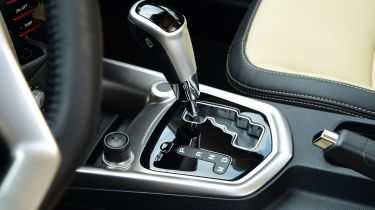What is a torque converter gearbox?
The torque converter automatic gearbox has been around for a long time, but how does it actually work?

A torque converter is a type of automatic gearbox, but what does it actually do and what are the benefits of choosing a car with one fitted? In this article we’ll explain how torque convertor gearboxes work without too much technical jargon and provide some reasons why you might want one.
Torque converter gearboxes are automatic, but not all automatics are torque converters. Some cars use something called a dual-clutch gearbox, while others use a continuously variable transmission (CVT) instead. All of these are automatic - you don’t change gears yourself - but they all work in different ways.
Automatic cars have been around for longer than you might think and from the early days of motoring until relatively recently, the torque converter type was used.
How a torque converter gearbox works
There are two parts to a car’s transmission, whether it’s manual or automatic. There’s the part with the gears and the part that attaches those gears to the engine, allowing the engine to turn the gears and drive the wheels.
In a car with a manual gearbox, the clutch is the part that connects to the engine: when the clutch pedal is not pressed, a plate is pushed up against the engine and this lets the engine turn the gears in the gearbox. When you press the clutch pedal, the plate moves away. This disengages the gears from the engine to allow a gear change to take place or for the car to stop without the engine also stopping and stalling the car.
Since there’s no clutch pedal in an automatic car, there needs to be a way for the engine to keep turning without the gears (and therefore the wheels) also turning. This is where the torque converter gearbox comes in. It takes the place of the clutch, transmitting the rotational force from the engine to the gears but also breaking the connection when the car needs to stop.
To do this, torque converters use hydrodynamics in what is known as a fluid coupling. They look like metal doughnuts and inside are a pair of turbine fans facing each other. The first fan is the impeller. It’s turned by a shaft connected to the engine. The other turbine fan is connected to the gears.
The torque converter is filled with thick transmission fluid and as the engine’s revs rise the impeller spins faster, causing the transmission fluid to also spin. In turn, the spinning fluid causes the other turbine fan connected to the gears to rotate, turning the car’s gears and driving the wheels. Through this process a fluid coupling is formed between the engine and gearbox.
The torque converter also includes a part called a sator right at its centre. This stops fluid from spinning in the opposite direction, entering the impeller and slowing it down. This has the effect of improving efficiency, making sure more of the engine’s torque is transmitted through the torque converter to the gearbox.
Because the fluid coupling in a torque converter is only created when the impeller spins quickly enough to turn the transmission fluid, the engine can keep turning when the car is stopped, without also turning the wheels. This allows drivers of torque converter automatic cars to sit at the traffic lights with a foot on the brake and the engine running, ready to move off when the lights change.
What are the benefits of a torque converter gearbox
Torque converter autos are very smooth and the torque multiplying effect they have means that they can get the car going from very low revs - this is why cars with torque converters creep forward when you let off the brakes. This effect is really useful in traffic and slow speed driving, where you can just use the brake pedal to stop and release it to start moving.
Other automatic gearboxes also creep, but they do this using electronics rather than as a purely mechanical process, so they can be quite jerky in traffic. Torque converters have a complex sun-and-planet gear system inside but this is good for saving space, so you can fit lots of gears inside - Ford even offers a ten-speed torque converter in its Mustang sports car.
What are the drawbacks of a torque converter gearbox
Torque converters are often called slushboxes by their critics: they typically weren’t as responsive as other types of gearbox and particularly older ones weren’t very fast at changing gears.
However, modern autos are controlled with software and are able to change gear incredibly quickly, so this drawback is largely eliminated. BMW has returned to torque converters for its sporty models after experimenting with automated manuals and dual-clutch gearboxes, for example.
Older torque converters were also quite poor at transferring engine power to the wheels at higher speeds, but advances in tech fixed that issue as well.
Modern torque converters are great at just about everything unless you really need the extra engagement and fun of using a manual gearbox, which no auto can really provide.
Do you own a car with a torque converter gearbox? Let us know your experience in the comments section below...





